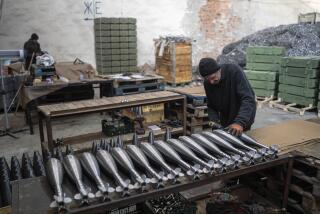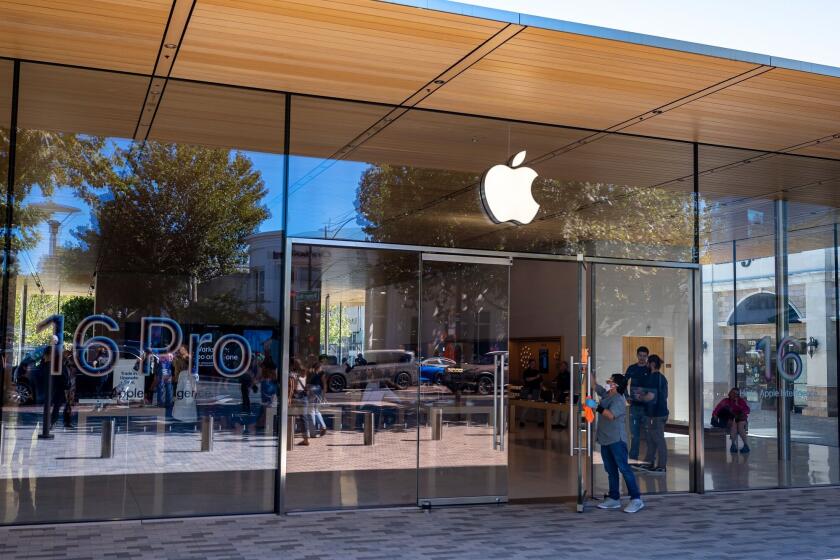East Europe’s Realities Put Chill on Investment Climate : Capitalism: Countless U.S. businesses have aborted or modified their entry into the former Communist bloc.
- Share via
The Marriott Corp.’s first move into Eastern Europe--a hotel it opened two years ago in downtown Warsaw--has been, the company says, a rip-roaring commercial success.
The Marriott Warsaw’s room rates--in the $200-a-night range--and its overall revenues are twice what the firm had planned for, says Nick Ward, Marriott’s vice president for international development.
“We are wildly enthusiastic,” he says.
But Marriott’s efforts to duplicate its Warsaw triumph have been foiled repeatedly across Eastern Europe--in Prague, Czechoslovakia; Budapest, Hungary, and Sofia, Bulgaria--and in the Soviet cities of Leningrad, Moscow and Kiev, as well. The company says it has been unable to find open downtown land, get clear title to property or solve the problem of what to do with displaced residents in a region where the waiting list for housing is measured in decades.
“It is,” says Ward, “approaching a conundrum.”
The Bethesda, Md.-based hotelier’s experience mirrors the initial euphoria of Western investors eyeing the market of some 130 million people unveiled by the parting of the Iron Curtain--and the cold dose of reality that followed close behind.
Blaming everything from state bureaucracy, regional politics and the recession in the West to radical environmentalists and demands for bribes from entrenched Communists, countless American investors have aborted, delayed or scaled back their entry into Eastern Europe.
“Ninety percent of the American businessmen who come here go right back home,” says Thomas S. Scharf, the president of a New York housing construction and management firm, who has launched a project in Poland.
Consider the kinds of problems they confront:
* A Polish steelmaker offering itself for sale claimed to be earning generous profits, but a deal fell through when U.S. investors realized the manufacturer had been getting its iron ore “free” from the state.
* An equipment deal stalled after a Polish bureaucrat grilled a California businessman seeking a license: “Are you a Jew? You look like a Jew to me.”
* Partners of a big U.S. motel chain say it was scared away from Czechoslovakia by a low-level Communist bureaucrat who demanded a “fee” to facilitate paperwork, illegal under U.S. bribery laws.
* New Hampshire resort developers proposing a major ski complex complain that they were driven out of Czechoslovakia’s Tatras Mountains by the environmentalist Greens party.
“And you wonder why Americans aren’t investing over there,” exclaims Martin Sumichrast, a Washington, D.C., businessman who says he has spent the past 18 months tilting at the windmills of Eastern Europe.
Many business strategists say they didn’t realize how hard it would be to sweep away the cobwebs formed during 50 years of central economic planning. Some top U.S. executives say the opportunities have been exaggerated. And critics say some Americans have been unrealistic, short-sighted or too conservative, ceding opportunities to Germans and others.
For all the problems, the potential remains vast to Marriott and other U.S. investors, and tantalizing opportunities seem to abound. There are initial successes and encouraging tales of innovation. And for many, the whole idea of planting free enterprise in tired socialist soil retains an historic and sometimes personal dimension.
“This is the country I was born in, and I’ve watched the political process from afar,” says George Varga, a Hungarian emigre and career General Electric executive who heads a big GE venture in Budapest. “But I know that the economic process, in the end, is going to be the important one.”
It’s just that it is taking so long.
“I’ve gotta admit, I was really excited,” recalls Cliff Clarke, corporate manager for international trade and policy at Digital Equipment Corp., the Maynard, Mass., computer maker. DEC has a joint venture with a Hungarian firm that is selling computer systems to banks, utilities and universities.
“It boggled my mind,” Clarke says. “There’s a wholesale recognition of a need to construct totally new systems that have to be compatible with the rest of the world. It involves every dimension of what makes up an industrial society.”
And while that “initial appraisal was accurate,” he says, “the political movement is a lot slower than I would have thought. And problems with putting money in banks, using the telephones--all the layers of bureaucracy that we also see as the opportunity--all tend to create more drag than we expected.”
Nonetheless, DEC has 80 Hungarians--versus a projected 30--scrambling to meet a stronger than expected demand for its computers. The company encountered a large population of sophisticated computer technicians in Budapest who grew up with early DEC-style computers that had been crudely but credibly cloned by Warsaw Pact manufacturers.
Says Clarke: “They sort of ran the way ours did. The software side, the mathematics, is very good. The manufacturing is where their flaws became very evident.”
Collectively, the privatization and democratization of Eastern Europe means more politically than economically to the United States, some experts say. The business potential of the three nations where most of the investment is going--Poland, Hungary and Czechoslovakia--is limited by a combined population of just 64 million, half that of Brazil.
Within certain industries, nonetheless, the competitive stakes can be high. How high, though, is disputed--nowhere more starkly than in the auto industry.
General Motors has hustled along with Volkswagen, Fiat and Suzuki to set up plants in Eastern Europe that will produce cars and components for export. The exports will earn credits entitling the firms to import the Western cars that will meet an expected demand for modern vehicles.
GM, uncharacteristically nimble in the face of massive financial problems at home, quickly committed more than $800 million to new production facilities in eastern Germany and Hungary and is deep in negotiations with Poland. The outlay includes a $630-million assembly plant being built in Eisenach, Germany.
“We are extremely pleased we moved aggressively,” says Jack Smith, GM’s vice chairman. “The industry there is so old and obsolete, there is not only growth but an opportunity to replace the existing car companies.”
Ford Motor Co. doesn’t see the opportunity.
Like GM, Ford long has been a major builder of cars in Western Europe. But Ford has been throwing darts at the Eastern European balloon, arguing that it will take 20 years for those economies to reach the stage that Spain and Portugal have reached today.
“It’s not the best single area to look at,” says Louis R. Ross, Ford’s executive vice president for international automotive operations. “What about Turkey and Greece?”
So far, consumer demand in the old East Bloc for new and used Western cars has been brisk. But Ross predicts Eastern Europe’s existing auto makers will continue indefinitely to supply more than 90% of local sales, because consumers don’t have the billions of dollars in hard currency it would take to replace all their domestic autos with ones from the West.
“Did you ask (GM) where these people are going to get the $30 billion a year?” Ross asks.
Ford is hedging its bets by building an $80-million fuel-pump plant near Budapest that will supply its assembly plants in the West. Meanwhile, Ross says Ford can move more aggressively into Eastern Europe any time. To those who call that shortsighted, he notes that most Japanese auto producers are also holding back from that chaotic part of the world.
“They walk on water,” Ross says sardonically of the Japanese, “and we’re walking right along behind them.”
Whichever approach proves smartest, disagreements over a market’s potential aren’t unusual. What’s new about Eastern Europe is that the very ground is shifting, confounding planners in big and small ways.
GM, like many other companies, has already had a taste of volatile regional politics.
The auto maker recently dropped plans for a transmission factory in Czechoslovakia because, says a Czech-American go-between, the project took a back seat among government officials to the passionate debate over Slovak independence.
“They were so goddamn busy with this independence thing that GM couldn’t get them to negotiate,” says Milos Voboril, a steel importer from Woodbury, N.Y., and the nephew of a GM Opel distributor in pre-World War II Prague.
In a region where heavy industry already dominates local economies, reinventing an auto industry is a high priority, because it also nurtures steel, rubber, glass, electronics, machine-tool and other core businesses. Thus, U.S. auto suppliers have begun moving into Eastern Europe, getting in on the ground floor of whatever is ultimately to be erected.
Guardian Industries, a privately held glass producer based in Northville, Mich., learned, however, that being early in that uncertain region has its pitfalls.
Attracted by the glass-making tradition in Hungary and eventual prospects for peddling glass for autos, Guardian figured it would get started with a $120-million architectural glass plant through a joint venture with state-owned Hungarian Glass Works in Oroshaza. The modernized plant re-opened in February with 250 employes.
When it drew up the plans for the operation a few years ago, Guardian counted on cheap Soviet natural gas; energy accounts for as much as 25% of the cost of making glass. Now, the end of Soviet gas subsidies to the former Warsaw Pact nations has put Guardian’s new plant in a hole.
“The cost of natural gas has doubled, and we have to use hard currency to buy it,” says Pete Walters, group vice president at Guardian. Though quality is high and profitability is “close,” Walters says, “the project isn’t quite as attractive as it looked.”
A strong local preference for joint ventures between state-owned firms and Western investors, meanwhile, saddles outsiders with decades of baggage--notably bloated worker ranks and the politically daunting task of laying people off. By some estimates, up to one-third of Eastern Europe’s current work force could be sent home without affecting production.
The Poles, for example, are trying to persuade Westerners to buy into an auto factory with 10,000 workers making 45,000 cars a year. A modern Western plant needs perhaps 3,000 workers to build 250,000 cars a year.
“What do you do with the people?” asks GM’s Smith. “We can’t use 10,000 people.”
Meanwhile, high inflation rates plague exporters.
General Electric, which bought control of Hungary’s biggest industrial firm, light bulb maker Tungsram, is making lamps and shipping most of them to the West. But wage increases of 16% to 22% have failed to match inflation--which in Hungary is running at a 35% annual clip--and the unrealistic official value of Hungary’s currency makes it hard to price GE’s products profitably in Western markets.
“You find your margins eroding rapidly, and it’s very difficult to get the government interested in this subject,” says Varga, president of the GE-Tungsram venture. “By and large, this government still hasn’t quite learned how to live with business.”
Uncertainty of this magnitude adds up, and it is a big reason why economists have predicted that Eastern Europe will attract just $10 billion to $20 billion of the $70 billion in foreign capital it would need annually in the 1990s to reach a par with Western Europe.
Yet many of the same investors who recite the difficulties are boosters as well. Despite the nightmares, the dream seems quite alive.
One big appeal of Eastern Europe for Western business is the rare combination of a skilled, educated work force and low wages. Though worker habits have been dulled by decades of subservience, the literacy rate is high, technical skills are strong and pay scales are of the Third World variety.
Listen to Varga, whose headquarters in Fairfield, Conn., just decided to pump another $47 million into the Tungsram venture, bringing the total to about $200 million. Though it is losing money by Hungarian accounting rules, he says, GE-Tungsram is profitable by U.S. standards.
“Most Westerners imagine that all these companies are totally backward, and it’s not always true,” says Varga. “At Tungsram, there are pockets of excellence. The workers are not lazy at all. They hate to do shoddy work, and they hate to work with shoddy components.”
GE-Tungsram is turning one of its dozen Hungarian plants into GE’s sole world source for fluorescent “quad” tubes, a hot new lighting technology.
Though wage rates are forecast to climb rapidly as the developing economies integrate with Western Europe, they remain seductive to any capitalist.
In the auto industry, Hungarians are making about $3.60 an hour, including benefits, according to industry estimates. That compares to $24 in the former West Germany and $17 in England. There are similar spreads in other industries.
That was the chief reason bicycle maker Schwinn Co. of Chicago chose Hungary for its first European plant, acquiring 51% of the state-owned bike maker Csepel. The company modernized the Csepel plant, eliminated about one-third of the work force and has gone from making heavy, 1950s-vintage bicycles to modern mountain bikes and beach cruisers. About half are exported to the United States and Western Europe.
Only Schwinn’s fourth plant--the others are in China and the United States--the Hungarian facility is being counted on to build 350,000 bikes a year. That would be more than one-third the total of Schwinn’s best year, 1987, when the company sold 1 million bicycles.
“Our targets so far have been reached ahead of schedule,” says Linda Pascucci, Schwinn’s international accounts manager. “We’re just generally pleased and surprised with the willingness of the workers. They’ve very hungry, very willing. We’ve had better quality from that plant than from other sources.”
Except in Hungary, the U.S. role in Eastern Europe remains far smaller than that of other Western nations. Though some political leaders in Eastern Europe want more U.S. investment to dilute a growing German presence, longstanding trade patterns mean that the dominant role of Germany and other West European investors in the burgeoning democracies is to be expected, says Douglas Gustafson, director of European investment for International Finance Corp., the private banking arm of the World Bank.
But U.S. brand names can be powerful marketing tools in Eastern Europe.
Coca-Cola, based in Atlanta, says 99% of East Germans knew about Coke, even though it hadn’t been sold there in 40 years. Within four months of the opening of the Berlin Wall, the bottling giant had sold about 17 million cans and bottles--or one for every resident of the old German Democratic Republic. It has since pledged more than $500 million in investment in eastern Germany, Poland and Hungary.
And U.S. technology still has admirers in the former East Bloc.
The ingredients that built the much-envied U.S. phone system are being hawked aggressively by such telecommunications firms as American Telephone & Telegraph, U.S. Sprint and others, all bidding on massive projects to upgrade the old wire networks that connect--or don’t connect--the region.
Among the contestants is Denver-based U.S. West. Its $11-million investment has put cellular phones in the hands of 5,000 Hungarians, with an ultimate goal of 50,000 customers. U.S. West has signed a $50-million cellular deal in Czechoslovakia, as well.
Cellular service can be established quickly to satisfy the screams of the burgeoning business community for working phones.
If cellular phones seem an extravagance in nations where more basic needs go unmet, telecommunications consultant David Mureeba offers a different perspective. Mureeba’s firm, Global Electro-Comm in Dallas, studied Poland’s telephone system for the State Department.
“Eastern Europe used a system for the last 50 years that intentionally discouraged communication,” he says. “We say that if over 33% of the people can be in touch with each other, you cannot control the society.”
U.S. Companies in Eastern Europe
While American firms have been slower than those in other nations to invest in the rebuildingof Eastern Europe, the list of U.S. projects is growing. Here are examples of large-scale U.S. corporate investment in manufacturing and commerce in the region. Some dollar figures are estimates.
Amount Company Country (millions) Type of Project General Motors Eastern Germany $630 Car assembly Hungary $200 Car assembly, engine production Coca-Cola Eastern Germany $450 Soft drink plants, distribution network in 12 cities Hungary $14 Bought control of two bottling plants Poland $110 11 new bottling plants General Electric Hungary $197 Bought 75% of lighting manufacturer Tungsram Guardian Industries Hungary $120 Bought 80% of Hungarian Glass Works Golub & Co. and Poland $100 Office complex A. Epstein & Sons Ford Hungary $80 Fuel pump, ignition coil production Sara Lee Hungary $50-$60 Bought control of food firm Compack Schwinn Hungary n.a. Bought control of bike maker Csepel U.S. West and Czechoslovakia $50 Cellular phones Bell Atlantic Marriott Poland $20-$40 Hotel U.S. West Hungary $11 Cellular phones United Technologies Hungary $10 Auto wiring harness production
Sources: investors, government agencies, published reports
Foreign Investment at a Glance
Czechoslovakia
By May 31, close to 3,000 foreign firms had entered into joint ventures with Czechoslovakia’s government. In volume of ventures, U.S. investors were in last place with a total of 132. Germans had 861 ventures, followed by Austrians with 821, Swiss with 197 and Italians with 134. Foreign companies invested $37 million in Czechoslovakia during the first quarter of 1991, bringing the total foreign investment to $211 million, up from $70 million in 1989.
Eastern Germany
The Treuhandanstalt--the trust agency in charge of privatizing eastern Germany’s economy--currently lists more than 7,000 companies for sale. About 2,140 have been sold since the two Germanys were united in October, 1990, amounting to a total investment of $5.3 billion. The agency anticipates an additional $34.5 billion in investments related to the initial sales. Through May, 90% of eastern Germany’s foreign investment was made up of western German capital. Of the remaining 10%, France, Britain and Japan had larger shares than the United States did. Between March, 1990, and March, 1991, only 17 U.S. firms invested in eastern Germany.
Hungary
With investments totaling $750 million by the end of May, the United States ranks first among Hungary’s foreign investors, followed by Germany with $400 million and Austria with $200 million. Total foreign investment, which accelerated from $400 million in 1989 to $1.2 billion in 1990, had climbed to about $1.6 billion by May 31.
Poland
Foreign investment in Poland through the first quarter of 1991 totaled $350 million. By June 30, the Polish government had issued 4,350 permits for foreign ventures, amounting to about $600 million in capital investment. Germany topped the list of investors with 1,150 permits and $168 million, followed by the United States with 284 permits and $48 million and Sweden with 300 permits and $44 million.
Sources: Privatization agencies, embassies
Times staff writer Joel Havemann, in Warsaw, contributed to this story.
More to Read
Inside the business of entertainment
The Wide Shot brings you news, analysis and insights on everything from streaming wars to production — and what it all means for the future.
You may occasionally receive promotional content from the Los Angeles Times.










